#313 Tomorrow's picture: April 27, 1996
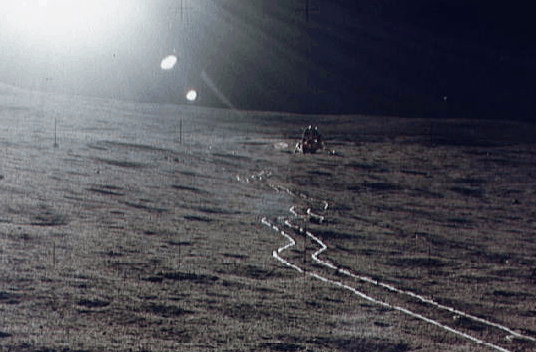
“Brilliant sunlight glints off tracks gently winding across the the Moon's Frau Maro highlands. The tracks were made by the Apollo 14 crew's two-wheeled Modularized Equipment Transporter (MET), fondly known as the "rickshaw". The MET was designed as an aid to surface exploration. Serving as a workbench with a place for the lunar handtools, it also carried cameras, sample containers, spare film and a Lunar Surface Penetrometer. The path outlined in the lunar soil leads away from Alan Shepard and Edgar Mitchell's Lunar landing Module, tracing the path of their first venture across the lunar landscape."
Copyright: Public domain
#314 Latest Comet Hyakutake images: April 28, 1996
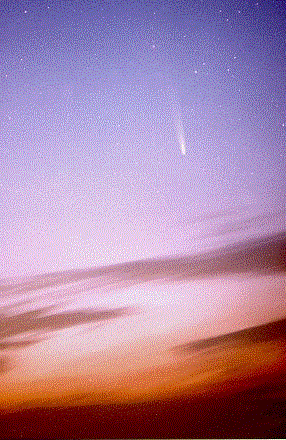
“Comet Hyakutake is seen here just as the Sun sets on April 22. As April draws to a close, Comet Hyakutake will be visible only just after sunset and will be hard to discern against the brightly lit sky. Unfortunately, Comet Hyakutake did not brighten as much as hoped during its journey to the inner Solar System, and is now not supposed to get as bright as it did when it passed the Earth in late March. Nevertheless, Comet Hyakutake is still a bright comet and spectacular sight. Latest Comet Hyakutake images: APOD Hyakutake Archive, JPL, Fayetteville Observer-Times, NASA's Night of the Comet, ICSTARS, Jerry Lodriguss, ScienceWeb, Crni Vrh Obs.,"
Copyright: Public domain
#315 Tomorrow's picture: April 29, 1996
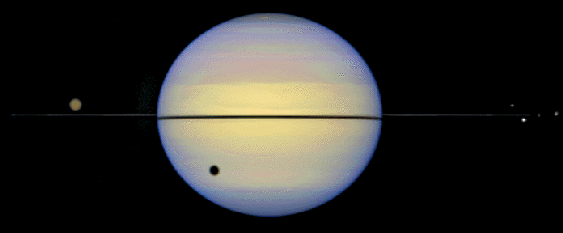
“Saturn's rings are actually very thin. This picture from the Hubble Space Telescope was taken on August 6, 1995 when the rings lined up sideways as seen from Earth. Saturn's largest moon Titan is seen on the left, and Titan's shadow can be seen on Saturn's cloud tops! Titan itself looks a brownish color because of its thick atmosphere. Four other moon's of Saturn can be seen just above the ring plane, which are, from left to right: Mimas, Tethys, Janus, and Enceladus. If you look carefully, you will note that the dark band across the planet is actually the shadow of the rings, and is slightly displaced from the real rings - which are best seen away from the planet. Saturn's rings are not solid - they are composed of ice chunks which range in size from a grain of sand to a house."
Copyright: Public domain
#316 Tomorrow's picture: April 30, 1996
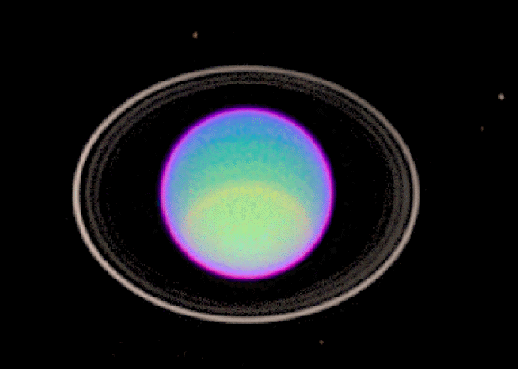
“The rings of Uranus are thin, narrow, and dark compared to other planetary ring systems. Brightened artificially by computer, the ring particles reflect as little light as charcoal, although they are really made of ice chucks darkened by rock. This false-color, infrared picture from the Hubble Space Telescope taken in July 1995 shows the rings in conjunction to the planet. The infrared light allows one to see detail in different layers of Uranus' atmosphere, which has been digitally enhanced with false color. Three other planets in our Solar System are known to have rings: Jupiter, Saturn, and Neptune. Four of Uranus' moons are visible outside the ring plane. The rings of Uranus were discovered from ground-based observations in 1977."
Copyright: Public domain
#317 Latest Comet Hyakutake images: May 01, 1996
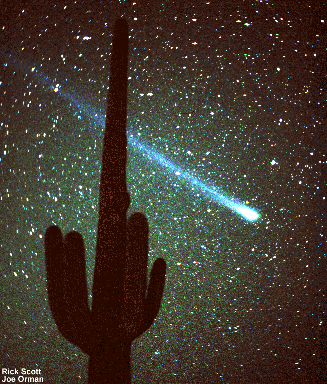
“Comet Hyakutake is shown photographed the night of March 27 in Arizona, USA, with a cactus in the foreground. Polaris, the north star, is the bright star seen just to the upper right of the comet's head. Today Comet Hyakutake reaches its closest approach to the Sun. Comet Hyakutake is now at its intrinsic brightest, but because of its distance from the Earth, it will appear less bright to us than it did during its closest approach to the Earth in late March. In fact, due to the comet's angular proximity to the Sun, it will difficult to see at all from the Earth! Comet Hyakutake will reach less than one quarter of the Earth-Sun distance - inside the orbit of Mercury. Comet Hyakutake will not venture near the Sun again for another about 15,000 years. Latest Comet Hyakutake images: APOD Hyakutake Archive, JPL, Fayetteville Observer-Times, NASA's Night of the Comet, ICSTARS, Jerry Lodriguss, ScienceWeb, Crni Vrh Obs.,"
Copyright: Public domain
#318 Latest Comet Hyakutake images: May 02, 1996
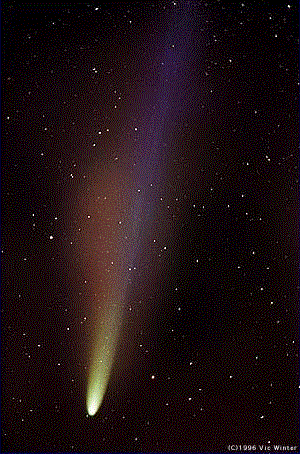
“What makes comet tails so colorful? This photograph of Comet Hyakutake was taken the night of April 18th and highlights different components of the tail. The gold and red tail features are dust, made predominately of little bits of rock and carbon. The dust tail shines by reflecting sunlight. Extending past the dust tail is the comet's ion tail, shown here glowing in blue. The ion tail is composed mostly of ions of water, carbon monoxide, and cyanogen. The ion tail glows by emitting light when elections re-combine with electrically charged ions to make uncharged molecules. The photograph was taken just north of Kansas City, Missouri, USA. Latest Comet Hyakutake images: APOD Hyakutake Archive, JPL, Fayetteville Observer-Times, NASA's Night of the Comet, ICSTARS, Jerry Lodriguss, ScienceWeb, Crni Vrh Obs.,"
Copyright: Vic
WinterICSTARS
#319 Tomorrow's picture: May 03, 1996
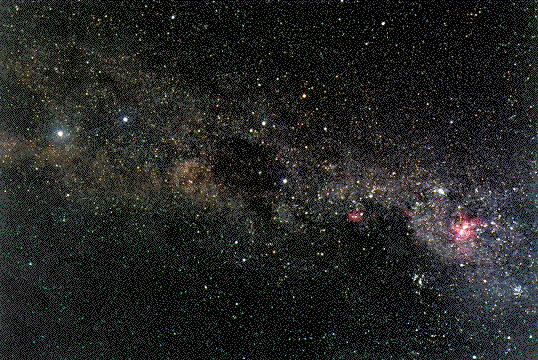
“This breathtaking patch of sky would be above you were you to stand at the south pole of the Earth. Just above and to the right of the photograph's center are the four stars that mark the boundaries of the famous Southern Cross. At the top of this constellation, also known as "The Crux," is the orange star Gamma Crucis. The band of stars, dust, and gas crossing the middle of the photograph is part our Milky Way Galaxy. In the very center of the photograph is the dark Coal Sack Nebula, and the bright nebula on the far right is the Eta Carina Nebula. The southern cross is so famous a constellation that it is depicted on the Australian National Flag."
Copyright: Greg
BockSouthern
Astronomical Society
Upvote! Resteem! Comment! As you like it! Thank you for attention!
#319 is so beautifull! Thinking about infinite space and miserable finite human live.
Downvoting a post can decrease pending rewards and make it less visible. Common reasons:
Submit